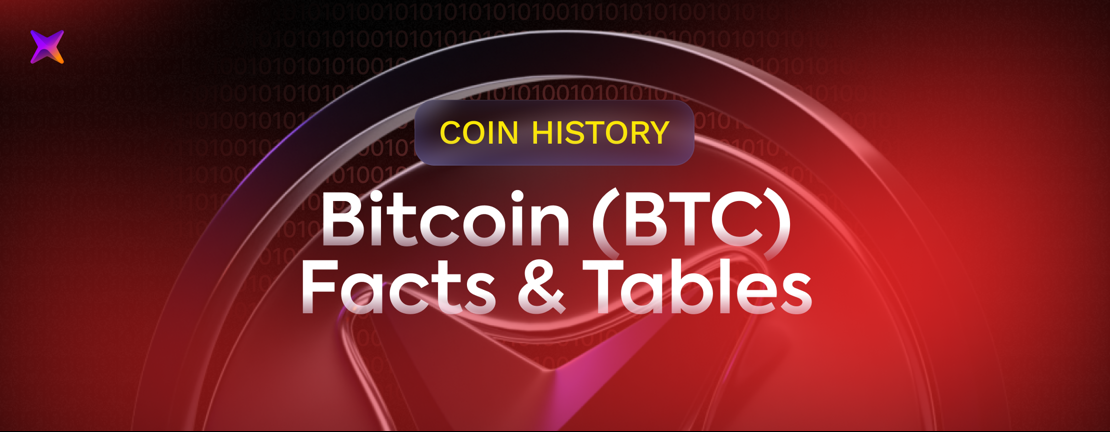Published 17 Oct 2025
Bitcoin History in Tables: Price, Halvings, Adoption

Bitcoin started in 2009 as open-source money with no central owner. It runs on a public network that issues new coins on a fixed schedule and secures itself with computing power.
Over time, it moved from an experiment to a trillion-dollar asset held by retail, institutions, and ETFs. The path wasn’t smooth. It came with manias, crashes, and long recoveries. Yet each cycle built a stronger base: better infrastructure, deeper liquidity, and a more resilient network.
This report tells that story with data and tables. You’ll see Bitcoin’s price on a logarithmic scale, market cap growth, and the 4-year halving cycles that shape supply.
We map major drawdowns and recoveries, show how volatility has changed, and plot an adoption timeline from corporate treasuries to U.S. spot ETFs. We also track network fundamentals — hashrate, addresses, and settlement volume — to show what’s happening under the hood.
You’ll find a simple seasonality view, a scale check versus gold and equities, and an S2F “Models Corner” to frame ranges — used carefully, not as a promise.
Price Evolution (2009-2025)
Below is a clean table of Bitcoin’s year-end levels and context. It replaces any talk of charts and keeps the focus on the numbers.
Bitcoin by Year — Price, YoY Change, Key Event
| Year | Price (USD) | YoY Change | Key Event |
|---|---|---|---|
| 2009 | 0.0009 | — | Genesis block |
| 2010 | 0.30 | 33,233% | First real transaction |
| 2011 | 4.25 | 1,317% | First major bubble |
| 2012 | 13.50 | 218% | First halving |
| 2013 | 754 | 5,485% | Silk Road, $1K milestone |
| 2014 | 320 | −58% | Mt. Gox collapse |
| 2015 | 430 | 34% | Market bottom |
| 2016 | 963 | 124% | Second halving |
| 2017 | 14,156 | 1,370% | $20K peak, mainstream wave |
| 2018 | 3,847 | −73% | Crypto winter |
| 2019 | 7,167 | 86% | Recovery begins |
| 2020 | 29,001 | 305% | COVID shock, institutional entry |
| 2021 | 47,733 | 65% | $69K ATH year, El Salvador |
| 2022 | 16,547 | −65% | Terra/FTX collapses |
| 2023 | 42,200 | 155% | Recovery year |
| 2024 | 108,000 | 156% | Spot ETFs, new ATH |
| 2025 | 113,214 | 5% | Post-halving year in progress |
How to read this table
-
Focus on direction across cycles (higher lows after each crash) rather than any single year.
-
Watch halving years (2012, 2016, 2020, 2024): they often precede strong next-year prints.
Large negative years cluster around credit/liquidity shocks and counterparty failures (2014, 2018, 2022).
What this shows
-
The long-term uptrend survived each deep drawdown and set higher floors in later cycles.
-
Supply cuts (halvings) and easier access (ETFs) align with the strongest up-years.
-
2025 sits as an early post-halving consolidation, following a big 2024 move.
Market Cap: From Billions to Trillions
Bitcoin Market Capitalization — Year-End Levels
Units: billions (2013–2020), trillions (2021–2024)
| Year | Market Cap | YoY Change |
|---|---|---|
| 2013 | $10.25B | — |
| 2014 | $5.23B | −49.83% |
| 2015 | $6.98B | +31.82% |
| 2016 | $17.18B | +144.47% |
| 2017 | $539.58B | +2,979.46% |
| 2018 | $126.01B | −77.44% |
| 2019 | $190.33B | +54.23% |
| 2020 | $741.22B | +294.43% |
| 2021 | $2.21T | +188.38% |
| 2022 | $802.98B | −64.00% |
| 2023 | $1.65T | +104.38% |
| 2024 | $3.27T | +96.77% |
How to read this table
-
2017, 2020–2021, and 2024 mark the acceleration phases that pushed Bitcoin into the trillion-dollar class.
-
Large down years (2014, 2018, 2022) line up with counterparty failures and liquidity stress.
-
The trend across cycles is a rising ceiling and a rising floor: each recovery rebuilt scale faster.
What this shows
-
Bitcoin graduated from a niche asset to multi-trillion scale, attracting institutions and ETF flows.
-
Drawdowns remain sharp, but recoveries compound to higher market cap plateaus.
-
Positioning 2025: post-halving, post-ETF environment with a much deeper capital base than prior cycles.
Halving Cycles: Supply Shock, Then Expansion
Bitcoin Halvings — Reward Cuts and Price Context
| Halving # | Date | Block Reward | Price Before | Price ~1 Year After | Change |
|---|---|---|---|---|---|
| 1 | Nov 28, 2012 | 50 → 25 BTC | $12.35 | $1,037 | +8,300% |
| 2 | Jul 9, 2016 | 25 → 12.5 BTC | $665 | $2,568 | +286% |
| 3 | May 11, 2020 | 12.5 → 6.25 BTC | $8,821 | $56,704 | +543% |
| 4 | Apr 20, 2024 | 6.25 → 3.125 BTC | $63,000 | $108,000* | +71%* |
Note: Figures for the 2024 halving are interim. The cycle is still unfolding.
How to read this table
-
Each halving cuts new supply in half; strong gains tend to show up after the event, not before.
-
The magnitude varies by liquidity and macro conditions, but the post-halving up-leg repeats across cycles.
What this shows
-
Halvings anchor market regimes: supply shock first, expansion later.
-
The 2024 halving sits in an ETF era, where access to BTC is easier for institutions — one reason the dataset shows a solid post-halving gain.
Crashes & Recoveries: What Broke, How Far It Fell, What Happened Next
Major Bitcoin Drawdowns — Peak to Trough
| Event | Date / Window | Peak → Trough | Drawdown | Trigger / Notes |
|---|---|---|---|---|
| Mt. Gox Flash Crash | Jun 2011 | $17 → $0.01 | −99.9% | Early market structure failure; thin liquidity |
| Mt. Gox Collapse | Feb 2014 | $800 → $400 | −50% | Exchange insolvency and lost coins |
| 2018 Bear Market | 2018 (to Dec) | $20,000 → $3,200 | −84% | Post-2017 deleveraging; ICO unwind |
| COVID Shock | Mar 2020 | $9,100 → $3,800 | −50% | Global liquidity squeeze and forced selling |
| Terra/FTX Cascade | 2022 | $69,000 → $15,500 | −77% | Stablecoin failure (UST/LUNA), CeFi/FTX collapse |
| $19.1B Liquidations | Mar 2025 | intra-cycle | n/a (derivatives event) | Largest single-episode liquidations in dataset |
| Tariff Headline Drop | Oct 2025 | $119,000 → $110,000 | −12% | Macro headline; fast snap then stabilization |
How to read this table
-
Focus on peak-to-trough depth and the type of shock (exchange failure, macro stress, derivatives wipe-out).
-
Notice that exchange/credit events (2014, 2022) cut deeper than macro blips (2020, 2025 tariff).
-
Post-shock phases in later cycles stabilize faster as market depth improves.
What this shows
-
Bitcoin absorbed multiple “death events” and still set higher highs in later cycles.
-
The worst drawdowns tie to counterparty and credit risk, not to block-level failures.
-
By 2025, shocks look shallower and shorter, consistent with a larger, more institutional market.
Volatility Is Trending Down
Annual Volatility — Daily Average by Year
| Year | Volatility |
|---|---|
| 2016 | 2.49% |
| 2017 | 4.13% |
| 2018 | 4.58% |
| 2019 | 4.06% |
| 2020 | 5.17% |
| 2021 | 4.89% |
| 2022 | 4.75% |
| 2023 | 3.92% |
| 2024 | 3.45% |
| 2025 | 3.12% |
How to read this table
-
Peaks line up with stress years (2018, 2020–2022).
-
Recent prints (2023–2025) are lower than earlier cycle highs.
What this shows
-
As the market deepens and institutions participate, swings compress outside shock periods.
-
Volatility is cycle-dependent: it spikes in crises, then grinds lower during expansions.
Adoption Timeline: Institutions, ETFs, and Policy
Key milestones
| Year | Milestone | Why it mattered |
|---|---|---|
| 2018 | MicroStrategy noted as first corporate buyer | A public company put BTC on the treasury map. |
| 2020 | Square buys $50M in BTC | Corporate treasury use moved from idea to action. |
| 2021 | Tesla buys $1.5B in BTC | BTC entered mainstream headlines and boardrooms. |
| 2021 | El Salvador makes BTC legal tender | First nation-state adoption; policy case study. |
| 2024 | U.S. spot Bitcoin ETFs approved (11 funds) | Regulated, easy access via brokerage and retirement accounts. |
| 2024 | BlackRock’s IBIT becomes largest spot ETF | Scale and brand brought new classes of buyers. |
| 2025 | Strategy holds 632,457 BTC | Corporate accumulation at multi-cycle scale. |
How to read this table
-
Each step reduced friction for large buyers (rules, custody, access).
-
Policy actions (legal tender, ETFs) expanded the addressable base beyond crypto-native users.
What this shows
-
Adoption is no longer just retail; it now includes corporations, funds, and governments.
-
The ETF era (2024–2025) explains steadier inflows and quicker post-shock stabilization.
Network Fundamentals: Hashrate, Addresses, Settlement
Security (hashrate), user base (addresses), and settlement (USD volume) — all trend higher. Below are clean tables instead of charts.
Hashrate (network security)
Units as provided; shows the order-of-magnitude growth.
| Year | Hash Rate | Note |
|---|---|---|
| 2009 | 7 MH/s | Early CPU era |
| 2015 | 500 GH/s | ASICs dominate |
| 2020 | 150 EH/s | Industrial-scale mining |
| 2025 | 750 EH/s | ~5× vs 2020 (user-provided) |
Wallet addresses (reach)
| Year | Addresses | Change vs prior row |
|---|---|---|
| 2015 | 5,000,000 | — |
| 2020 | 50,000,000 | +900% |
| 2025 | 220,000,000 | +340% |
Annual settlement volume (USD)
| Year | Volume | Change vs prior row |
|---|---|---|
| 2020 | $1.2T | — |
| 2025 | $3.8T | +217% |
How to read these tables
-
Treat them as directional gauges of network health: more security, more users, more value settled.
-
Orders of magnitude matter more than exact values.
What this shows
-
Security compounds: rising hashrate deters attacks and supports long-term confidence.
-
Reach expands: address growth points to a larger active and passive holder base.
-
Utility scales: higher settlement volume means the network moves more value, not just price.
Seasonality: Best and Worst Months
Historical performance clusters by month, but seasonality is weaker than cycles and liquidity. Use it as context, not a signal.
Monthly pattern
| Bucket | Months | Comment |
|---|---|---|
| Best | October, November, December | Year-end strength shows up across multiple cycles. |
| Worst | January, March, August | Early-year resets, tax effects, and thin summer liquidity. |
How to read this table
-
Seasonality varies by cycle and can be overridden by macro/liquidity shocks.
-
Treat month effects as background bias, not a trading rule.
What this shows
-
Late-year months often coincide with risk-on phases and cycle accelerations.
-
Weak months line up with position resets and lower participation (summer).
Bitcoin vs. Traditional Assets (Scale Check)
A size check helps anchor expectations. Here’s how Bitcoin stacks up against major asset classes.
Market cap comparison
| Asset | Market Cap (USD) |
|---|---|
| Bitcoin | $2.24T |
| Gold | $17.85T |
| U.S. Dollar (M2) | $21.35T |
| U.S. Stock Market | $58T |
How to read this table
-
Bitcoin is already a multi-trillion asset but still far smaller than gold and equities.
-
The gap between gold and stocks shows room for re-rating during risk-on macro cycles.
-
Larger base also means shallower percentage swings versus early years, even if dollar moves are big.
What this shows
-
Bitcoin has crossed into institutional scale, which supports broader adoption.
-
Future upside depends on share-of-value captured from stores of value and risk assets, not just crypto-native flows.
Models Corner: Stock-to-Flow (Use With Caution)
Stock-to-Flow (S2F) compares existing supply (“stock”) to new issuance (“flow”). Bitcoin’s block reward halves every ~4 years, so the S2F ratio rises over time and the model projects higher price ranges after each halving. It’s a lens, not a promise.
Input snapshot
| Metric | Value |
|---|---|
| Current S2F ratio (post-2024 halving) | 56 |
| Next halving year | 2028 |
| Projected S2F after 2028 | 112 |
Projected price ranges
| Year | Low | High | Mid |
|---|---|---|---|
| 2025 | $120,000 | $180,000 | $150,000 |
| 2026 | $200,000 | $300,000 | $250,000 |
| 2027 | $350,000 | $500,000 | $425,000 |
| 2028 | $500,000 | $1,000,000 | $750,000 |
How to use this section
-
Treat S2F as a scenario range anchored to supply, not a timing tool.
-
Real-world outcomes depend on liquidity, demand, regulation, and leverage.
-
Past cycles showed large deviations from S2F paths during shocks (exchange failures, macro stress).
Bottom line
S2F is helpful for framing long-run scarcity, but decisions should also consider adoption, market depth, and risk conditions covered elsewhere in this report.
The 4-Year Framework: What History Suggests
Bitcoin’s market rhythm lines up with the halving schedule. Supply gets cut, demand adapts with a lag, and price discovers a new range. The exact timing varies, but the pattern repeats.
Cycle checkpoints
| Phase | Typical Window | What Changes | Markers in the Data | What to Watch Next |
|---|---|---|---|---|
| Pre-Halving Setup | ~6–12 months before halving | Positioning builds; narratives form | Rising addresses; steady hashrate growth | Liquidity in USD, leverage in derivatives |
| Halving Event | Halving month | New issuance halves | Block reward cut (e.g., 6.25 → 3.125 BTC in 2024) | Miner margins, fee share in miner revenue |
| Post-Halving Expansion | ~6–18 months after | Demand meets reduced flow | Strong YoY gains (2013, 2017, 2021, 2024) | ETF/treasury flows, policy headlines |
| Mid-Cycle Shakeouts | Any time | Overheated leverage resets | Sharp drawdowns (2018, 2020 shock, 2022, Mar/Oct 2025) | Funding rates, open interest, credit stress |
| Late-Cycle Distribution | After new highs | Gains slow; volatility compresses | Lower daily vol vs. prior spikes | Net flows cooling, breadth narrowing |
| Bear/Reset | 6–18 months | Deleveraging; bases form | Deep drawdowns, then higher lows vs. prior cycle | Spot bid strength, time above prior ATH |
What this framework tells you
-
Supply anchors the rhythm; demand sets the amplitude. Halvings create the backdrop; access improvements (ETFs, corporate treasuries) decide how far and how fast the expansion runs.
-
Recoveries arrive faster on a larger base. Later cycles show shallower, shorter shocks and quicker stabilization near higher floors.
-
Volatility is path-dependent. It spikes in stress windows, then trends lower as participation broadens and plumbing improves.
Positioning 2025 in this map
We’re in the early post-halving phase with ETF demand in the mix. The dataset shows a strong 2024 print, a high base into 2025, and quick stabilization after shocks. Next checkpoints: durability of inflows, miner economics post-cut, and how policy/liquidity shape the remainder of the cycle.
Risks & What to Watch
Short, practical checklist. Each risk links to a metric already shown in our tables.
Core Risks
| Risk | Why It Matters | Where It Showed Up |
|---|---|---|
| Liquidity Shocks | Forced selling widens moves and gaps order books. | 2020 COVID drop; Mar 2025 liquidation wave; Oct 2025 tariff dip. |
| Counterparty/Credit | Exchange or lender failures trigger cascades. | 2014 Mt. Gox; 2022 Terra/FTX. |
| Policy/Regulation | Access can expand or shrink quickly. | 2024 ETF approvals (positive); earlier China mining ban. |
| Miner Economics | Post-halving margins affect hashpower stability. | 2024 reward cut to 3.125 BTC. |
| Leverage & Derivatives | Overheated funding/OI precede liquidations. | Mar 2025 wave in dataset. |
| Narrative/Flow Reversal | ETF/treasury inflows slow; retail fatigues. | Late-cycle cool-downs after new highs. |
What to Monitor
| Watchlist Item | Proxy Metric (from this report) | Signal to Track |
|---|---|---|
| Market Depth & Stress | Drawdowns table; Volatility table | Faster/shallower selloffs vs. prior cycles. |
| Institutional Demand | Adoption milestones; Market cap table | Persistence of ETF/treasury accumulation. |
| Supply Dynamics | Halvings table | Post-halving year-over-year prints. |
| Network Security | Hashrate table | Stable or rising after reward cuts. |
| User Base Growth | Addresses table | Continued expansion toward new cohorts. |
| Settlement Activity | Annual settlement table | Higher USD throughput beyond price moves. |
Bottom line
Large shocks still happen, but later cycles recover faster on a bigger base. Keep one eye on flows and credit (where crashes begin) and one eye on network and supply (why recoveries endure).
Final Summary
Bitcoin’s history in tables shows a clear pattern: supply halves on schedule, adoption expands in waves, and price grinds higher across cycles despite deep setbacks. Floors rise, recoveries come faster, and volatility trends lower outside shock windows.
What matters now:
-
Flows and credit drive crashes. Track liquidity, leverage, and counterparty risk.
-
Network and supply drive recoveries. Rising hashrate, growing addresses, and fixed issuance anchor the long term.
-
Access sets the amplitude. ETFs and institutional rails change who can buy, how much, and how often.
The current cycle is post-halving and ETF-enabled: steadier demand against lower new supply, with faster sentiment swings on headlines. Use the tables in this report as a checklist — price and market cap (pace), halvings (regime), drawdowns and volatility (stress), adoption milestones (access), and network metrics (durability).
Data doesn’t promise outcomes. It frames them. Stay focused on flows and credit for risk, and on network and supply for staying power.

 Get RateX Pro
Get RateX Pro

 06 Jun 2024
06 Jun 2024


